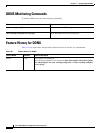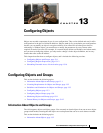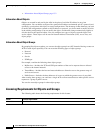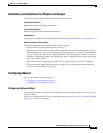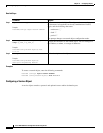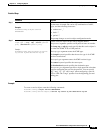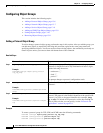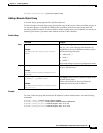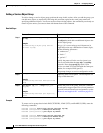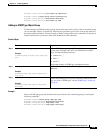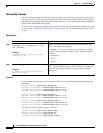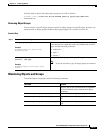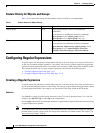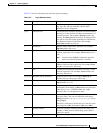
13-6
Cisco ASA 5500 Series Configuration Guide using the CLI
Chapter 13 Configuring Objects
Configuring Objects and Groups
Configuring Object Groups
This section includes the following topics:
• Adding a Protocol Object Group, page 13-6
• Adding a Network Object Group, page 13-7
• Adding a Service Object Group, page 13-8
• Adding an ICMP Type Object Group, page 13-9
• Nesting Object Groups, page 13-10
• Removing Object Groups, page 13-11
Adding a Protocol Object Group
To add or change a protocol object group, perform the steps in this section. After you add the group, you
can add more objects as required by following this procedure again for the same group name and
specifying additional objects. You do not need to reenter existing objects; the commands you already set
remain in place unless you remove them with the no form of the command.
Detailed Steps
Example
To create a protocol group for TCP, UDP, and ICMP, enter the following commands:
hostname (config)# object-group protocol tcp_udp_icmp
hostname (config-protocol)# protocol-object tcp
hostname (config-protocol)# protocol-object udp
Command Purpose
Step 1
object-group protocol obj_grp_id
Example:
hostname(config)# object-group protocol
tcp_udp_icmp
Adds a protocol group. The obj_grp_id is a text string up to 64
characters in length and can be any combination of letters, digits,
and the following characters:
• underscore “_”
• dash “-”
• period “.”
The prompt changes to protocol configuration mode.
Step 2
description text
Example:
hostname(config-protocol)# description New
Group
(Optional) Adds a description. The description can be up to 200
characters.
Step 3
protocol-object protocol
Example:
hostname(config-protocol)# protocol-object
tcp
Defines the protocols in the group. Enter the command for each
protocol. The protocol is the numeric identifier of the specified IP
protocol (1 to 254) or a keyword identifier (for example, icmp,
tcp, or udp). To include all IP protocols, use the keyword ip. For
a list of protocols that you can specify, see the “Protocols and
Applications” section on page B-11.



